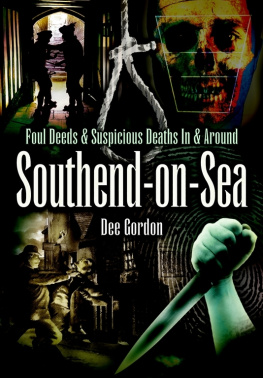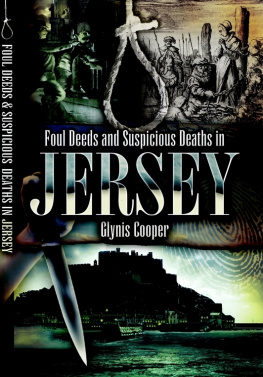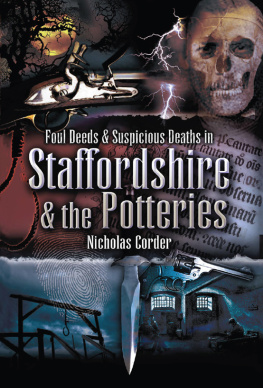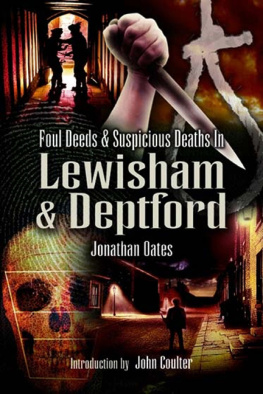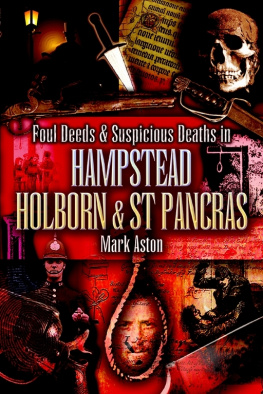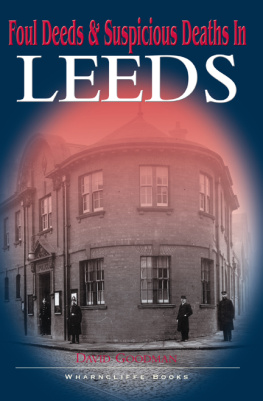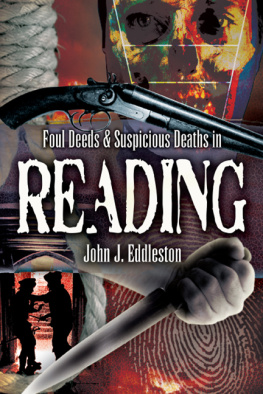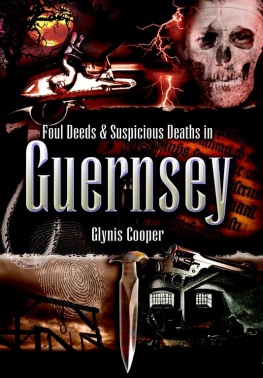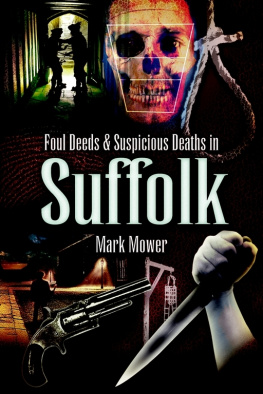
TRUE CRIME FROM WHARNCLIFFE
Foul Deeds and Suspicious Deaths Series
Barking, Dagenham & Chadwell Heath
Barnsley
Bath
Bedford
Birmingham
Black Country
Blackburn and Hyndburn
Bolton
Bradford
Brighton
Bristol
Cambridge
Carlisle
Chesterfield
Colchester
Coventry
Croydon
Derby
Dublin
Durham
Ealing
Folkestone and Dover
Grimsby
Guernsey
Guildford
Halifax
Hampstead, Holborn and St Pancras
Huddersfield
Hull
Leeds
Leicester
Lewisham and Deptford
Liverpool
Londons East End
Londons West End
Manchester
Mansfield
More Foul Deeds Birmingham
More Foul Deeds Chesterfield
More Foul Deeds Wakefield
Newcastle
Newport
Norfolk
Northampton
Nottingham
Oxfordshire
Pontefract and Castleford
Portsmouth
Rotherham
Scunthorpe
Southend-on-Sea
Staffordshire and The Potteries
Stratford and South Warwickshire
Tees
Warwickshire
Wigan
York
OTHER TRUE CRIME BOOKS FROM WHARNCLIFFE
A-Z of Yorkshire Murder
Black Barnsley
Brighton Crime and Vice 1800-2000
Durham Executions
Essex Murders
Executions & Hangings in Newcastle and Morpeth
Norfolk Mayhem and Murder
Norwich Murders
Strangeways Hanged
The A-Z of London Murders
Unsolved Murders in Victorian and Edwardian London
Unsolved Norfolk Murders
Unsolved Yorkshire Murders
Yorkshires Murderous Women
Please contact us via any of the methods below for more information or a catalogue.
WHARNCLIFFE BOOKS
47 Church Street Barnsley South Yorkshire S70 2AS
Tel: 01226 734555 734222 Fax: 01226 734438
E-mail: enquiries@pen-and-sword.co.uk
Website: www.wharncliffebooks.co.uk


To Reg Long
First published in Great Britain in 2009 by
Wharncliffe Books
an imprint of
Pen & Sword Books Ltd
47 Church Street
Barnsley
South Yorkshire
S70 2AS
Copyright Nick Papadimitriou 2009
ISBN 978 1 84563 064 5
eISBN: 978 1 78303 771 1
The right of Nick Papadimitriou to be identified as author of this work has been asserted by him in accordance with the Copyright, Designs and Patents Act 1988.
A CIP catalogue record for this book is available from the British Library.
All rights reserved. No part of this book may be reproduced or transmitted in any form or by any means, electronic or mechanical including photocopying, recording or by any information storage and retrieval system, without permission from the publisher in writing.
Typeset in 11/13pt Plantin by
Mac Style, Beverley, East Yorkshire
Printed and bound in the UK by
CPI
Pen & Sword Books Ltd incorporates the imprints of Pen & Sword Aviation, Pen & Sword Maritime, Pen & Sword Military, Wharncliffe Local History, Pen and Sword Select, Pen and Sword Military Classics and Leo Cooper.
For a complete list of Pen & Sword titles please contact
PEN & SWORD BOOKS LIMITED
47 Church Street, Barnsley, South Yorkshire, S70 2AS, England
E-mail: enquiries@pen-and-sword.co.uk
Website: www.pen-and-sword.co.uk
Preface & Acknowledgements
T he title of this book was originally to be Foul Deeds and Suspicious Deaths in the London Borough of Barnet. However, I felt that this made it sound like an official publication, which would be entirely at variance with my intention. In any case, the inclusion of London Borough of Barnet in the title would have been a bit of a misnomer: for example, the most recent murder covered in these pages occurred in July 1959, almost five years before the London Borough of Barnet came into being. Administratively speaking, the killing of Miriam von Young occurred in the Metropolitan Borough of Hendon. Nevertheless, the Borough of Barnet, as it currently stands, is the locale in which the tales of woe described in these pages take place. Therefore I will use the name Barnet as a metonymic contraction to stand in for the collection of towns, villages or parishes that would one day be constituent parts of the administrative borough of that name. However, in describing each particular murder, I specify the town in which it took place, e.g. Hendon or Finchley etc. This is in order both to be consistent with events involving coroners inquiries, newspaper reports and so forth, and to gain historical flavour. In accordance with my publishers wishes, the cut-off date for this book is 1960. This was deemed desirable in order to spare the feelings of the families of victims. There were no murders in Barnet in 1960, although there was one in 1959, and so that is where the story ends. Murder is never funny, and writing this history has been a strain at times. However, I feel that, as well as providing a useful contribution to local studies, these retrieved fragments of regional memory disasters and tragedies that extend like dark waves of recall far beyond the lives of both victim and persecutor enable the reader to bear witness to the injustice of murder.
Special thanks are due to the London Borough of Barnet (LBB in picture credits) at their local studies library for their help and kindness and for permission to use a selection of images from their collection.
Introduction
B arnet is the third largest London borough. It comprises the old Middlesex metropolitan boroughs of Hendon, Finchley and Friern Barnet as well as the former Barnet and East Barnet Urban District Councils, in Hertfordshire. These previously distinct administrative areas had roots that can be traced farther back to various parishes and manorial tracts.
The London Borough of Barnet perhaps epitomises the idea of the suburban, where that word is taken to mean dull and lacking in drama, both of human life and of physical feature. Yet a little effort applied to defamiliarising the landscape, either by purposeful exploration or through the study of local history, throws the place into stark relief once again if not for the first time. In order to frame the zone within which the murders described in this book occurred I undertook a series of long walks crossing the borough in order to examine the site of each killing.
It quickly became apparent that Barnet was not the featureless zone I had presumed it to be. On the contrary a quiet yet brooding power lurks in our hilly region of serried rooftops and arterial roads. A walk down the Hendon Way from my home in Childs Hill, in April 2007, revealed traces of the old Hendon Urban District Council sewage farm still visible in concrete culverts and the raised lines of a buried aqueduct at Brent Cross. Working up from there to Hendon, to Sunny Hill Park (noting along the way the old Hendon Corporation metals set into alleyways and road surfaces), I gazed over to the line of ridges running east to west along the northern rim of old Middlesex. I allowed my eyes to roll far off, across the landscape beyond Harrow-on-the-Hill, to Haste Hill at Ruislip and to windy Harefield on the western border of Middlesex. Next, after cutting through to Millfield Park in Mill Hill via Arrandene Open Space, I looked west once more. From here the elongated ridge of Kingsbury Hill, Barn Hill and Harrow (elongated ridges from this perspective) looked like dreadnoughts in line abreast. And further beyond twinkled the lights of distant trunk roads and the tower blocks at Hounslow Heath.
Next page


